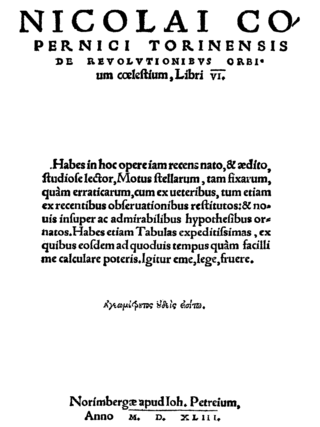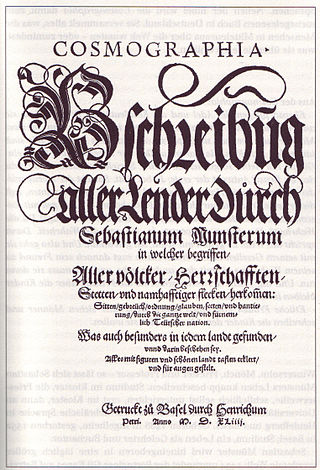
Erasmus Reinhold was a German astronomer and mathematician, considered to be the most influential astronomical pedagogue of his generation. He was born and died in Saalfeld, Saxony.
Georg Joachim de Porris, also known as Rheticus, was a mathematician, astronomer, cartographer, navigational-instrument maker, medical practitioner, and teacher. He is perhaps best known for his trigonometric tables and as Nicolaus Copernicus's sole pupil. He facilitated the publication of his master's De revolutionibus orbium coelestium.
This article contains information about the literary events and publications of 1540.

Nicolaus Copernicus was a Renaissance polymath, active as a mathematician, astronomer, and Catholic canon, who formulated a model of the universe that placed the Sun rather than Earth at its center. In all likelihood, Copernicus developed his model independently of Aristarchus of Samos, an ancient Greek astronomer who had formulated such a model some eighteen centuries earlier.

De revolutionibus orbium coelestium is the seminal work on the heliocentric theory of the astronomer Nicolaus Copernicus (1473–1543) of the Polish Renaissance. The book, first printed in 1543 in Nuremberg, Holy Roman Empire, offered an alternative model of the universe to Ptolemy's geocentric system, which had been widely accepted since ancient times.

Johannes Schöner was a German polymath. It is best to refer to him using the usual 16th-century Latin term "mathematicus", as the areas of study to which he devoted his life were very different from those now considered to be the domain of the mathematician. He was a priest, astronomer, astrologer, geographer, cosmographer, cartographer, mathematician, globe and scientific instrument maker and editor and publisher of scientific tests. In his own time he enjoyed a Europe-wide reputation as an innovative and influential globe maker and cosmographer and as one of the continent's leading and most authoritative astrologers. Today he is remembered as an influential pioneer in the history of globe making, and as a man who played a significant role in the events that led up to the publishing of Copernicus's De revolutionibus orbium coelestium in Nürnberg in 1543.
The year 1506 in science and technology included many events, some of which are listed here.

Michael Maestlin was a German astronomer and mathematician, known for being the mentor of Johannes Kepler. He was a student of Philipp Apian and was known as the teacher who most influenced Kepler. Maestlin was considered to be one of the most significant astronomers between the time of Copernicus and Kepler.

The Copernican Revolution was the paradigm shift from the Ptolemaic model of the heavens, which described the cosmos as having Earth stationary at the center of the universe, to the heliocentric model with the Sun at the center of the Solar System. This revolution consisted of two phases; the first being extremely mathematical in nature and the second phase starting in 1610 with the publication of a pamphlet by Galileo. Beginning with the 1543 publication of Nicolaus Copernicus’s De revolutionibus orbium coelestium, contributions to the “revolution” continued until finally ending with Isaac Newton’s work over a century later.

The Commentariolus is Nicolaus Copernicus's brief outline of an early version of his revolutionary heliocentric theory of the universe. After further long development of his theory, Copernicus published the mature version in 1543 in his landmark work, De revolutionibus orbium coelestium.

Achilles Pirmin Gasser was a German physician and astrologer. He is now known as a well-connected humanistic scholar, and supporter of both Copernicus and Rheticus.

Johann(es) Petreius was a German printer in Nuremberg.

Copernican heliocentrism is the astronomical model developed by Nicolaus Copernicus and published in 1543. This model positioned the Sun at the center of the Universe, motionless, with Earth and the other planets orbiting around it in circular paths, modified by epicycles, and at uniform speeds. The Copernican model displaced the geocentric model of Ptolemy that had prevailed for centuries, which had placed Earth at the center of the Universe.

The Prutenic Tables, were an ephemeris by the astronomer Erasmus Reinhold published in 1551. They are sometimes called the Prussian Tables after Albert I, Duke of Prussia, who supported Reinhold and financed the printing. Reinhold calculated this new set of astronomical tables based on Nicolaus Copernicus' De revolutionibus orbium coelestium, the epochal exposition of Copernican heliocentrism published in 1543. Throughout his explanatory canons, Reinhold used as his paradigm the position of Saturn at the birth of the Duke, on 17 May 1490. With these tables, Reinhold intended to replace the Alfonsine Tables; he added redundant tables to his new tables so that compilers of almanacs familiar with the older Alfonsine Tables could perform all the steps in an analogous manner.

Henricus Petrus (1508–1579) and his son Sebastian Henric Petri headed the printer shop of Basel, called Officina Henricpetrina.
Franz Rhode was a German printer of the 16th century.
The Nicolaus-Copernicus-Gesamtausgabe is a comprehensive, commented collection of works by, about, and related to Nicolaus Copernicus. The Gesamtausgabe includes Copernicus's surviving manuscripts and notes, his published writings, other authors' commentary about Copernicus and his works, a bibliography, and a biography.
Hieronymus Schreiber, also called Jerôme Schreiber, was a German doctor, mathematician and astronomer from Nuremberg.
The year 1540 in science and technology included a number of events, some of which are listed here.
The Wittenberg Interpretation refers to the work of astronomers and mathematicians at the University of Wittenberg in response to the heliocentric model of the Solar System proposed by Nicholas Copernicus, in his 1543 book De revolutionibus orbium coelestium. The Wittenberg Interpretation fostered an acceptance of the heliocentric model and had a part in beginning the Scientific Revolution.











